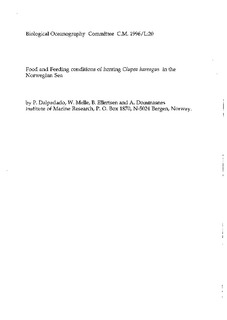| dc.contributor.author | Dalpadado, Padmini | |
| dc.contributor.author | Melle, Webjørn | |
| dc.contributor.author | Ellertsen, Bjørnar | |
| dc.contributor.author | Dommasnes, Are | |
| dc.date.accessioned | 2012-09-28T06:54:31Z | |
| dc.date.available | 2012-09-28T06:54:31Z | |
| dc.date.issued | 1996 | |
| dc.identifier.citation | This report is not to be cited without prior reference to the authors | no_NO |
| dc.identifier.uri | http://hdl.handle.net/11250/105605 | |
| dc.description.abstract | The feeding ecology of herring was studied using samples collected during cruises
in 1994 and 1995. Investigations were carried out in the Møre shelf region off
western Norway where the major spawning of herring occurs, and in the off shelf
area of the eastern Norwegian Sea, where herring migrate after spawning.
Our study shows low feeding activity of herring during their main spawning
season with the peak feeding period occurring in June and July. After spawning in
February - March herring fed upon euphausiids, mainly Thysanoessa inermis and
Meganyctiphanes norvegica on the shelf and at the shelf edge. In late spring and
summer herring which had migrated to the Norwegian Sea fed mainly on
Calanus finmarchicus, copepodite stages IV and older. In colder waters e.g., waters
influenced by East Icelandic Current, C. hyperboreus was important in the diet. In
the western part of the Norwegian Sea the zooplankton biomass was dominated
by amphipods, Themisto spp., which is also a major prey of herring in that region.
Herring were found to feed on fish at only a few stations.
The herring showed size selective feeding of copepodite stages of C. finmarchicus
and C. hyperboreous. There seem to be no selection between C. finmarchicus and
C. hyperboreous when the species were of similar size. Larger prey such as krill
were preyed upon regardless of their size. The amount of food ingested by herring
in April 1995 was comparatively higher in the Arctic water than in the Atlantic
water. The zooplankton biomass showed a similar distribution pattern. The
herring seem to be less selective in their feeding behavior in situations with low
prey concentrations such as in the warmer Atlantic waters. | no_NO |
| dc.language.iso | eng | no_NO |
| dc.publisher | ICES | no_NO |
| dc.relation.ispartofseries | ICES CM Documents;1996/L:20 | |
| dc.subject | herring | no_NO |
| dc.subject | sild | no_NO |
| dc.subject | feeding | no_NO |
| dc.subject | fôring | no_NO |
| dc.subject | fish behaviour | no_NO |
| dc.subject | fiskeatferd | no_NO |
| dc.title | Food and feeding conditions of herring Clupea harengus in the Norwegian Sea | no_NO |
| dc.type | Working paper | no_NO |
| dc.subject.nsi | VDP::Mathematics and natural science: 400::Zoology and botany: 480::Ethology: 485 | no_NO |
| dc.subject.nsi | VDP::Mathematics and natural science: 400::Geosciences: 450::Oceanography: 452 | no_NO |
| dc.subject.nsi | VDP::Agriculture and fishery disciplines: 900::Fisheries science: 920::Fish health: 923 | no_NO |
| dc.source.pagenumber | 36 s. | no_NO |
